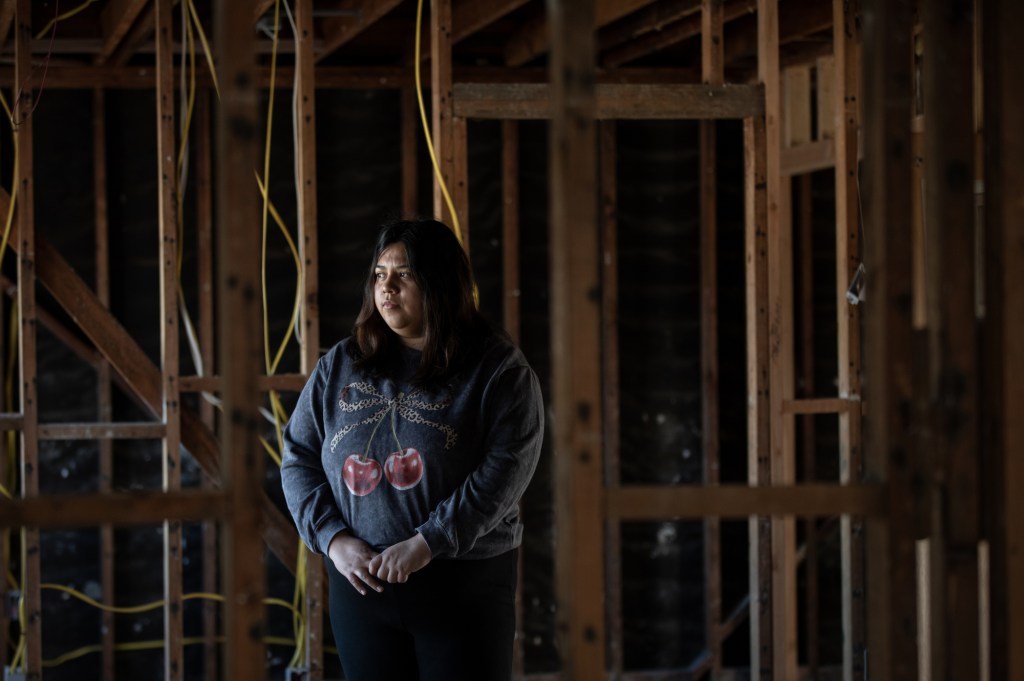
This year’s holiday season will feel very different for some San Diegans still trying to rebuild nearly a year after catastrophic flooding displaced thousands of families.
Some spent Thanksgiving day separated from their families, with nowhere to gather. Others used the time off to work on rebuilding, in the hopes of returning home before Christmas.
Others who are fortunate enough to have moved back home already still aren’t out of the woods.
And as the year winds to a close, Clariza Marin, who has been helping organize flood recovery efforts, worries about another cliff coming for flood victims.
Some had to hurry to lease new homes at rents higher than they can afford — leases that may soon expire. Others’ rental subsidies and other financial aid is running dry.
Soon, those families will have exhausted their resources and once again be in search of an affordable place to live.
“There’s so many lessons to be learned,” Marin said.
Martha Navarro considers herself one of the lucky ones. She was able to move back into her Southcrest home with her husband, two sons and their dog at the end of July — but it hasn’t been an easy transition.
Theirs is one of the few families who have moved back into their homes on Beta Street, one of the streets hit hardest in January. Many neighbors are still rebuilding; other homes are up for sale or have recently sold.
Her family’s flood insurance helped cover the costs of home repairs but not those of damaged appliances and belongings.
She estimates they’ve spent $20,000 to $25,000 already, but still lack many of the other key items that make up a home, like smaller kitchen appliances or cooking utensils. She’s bought only her essentials — things like pots, pans and a coffee maker.
“It was little things like that that made me upset, because I’m not trying to buy everything all over again, or remember exactly what I had,” she said.
Dozens of other families face similar situations or worse, explained Marin, who earlier this year became chief financial officer for the Harvey Family Foundation to help with its flood recovery efforts.

Although Marin hopes to return to her regular, full-time job soon, she and the nonprofit’s leader, Armon Harvey, say there is still so much work left to do to help flood victims.
“We’re doing outreach, door-knocking and … we’re still finding more houses that still need help,” Marin said. “There’s families with children sleeping on the floor with mold.”
More than 300 families have gotten financial aid since the county gave the San Diego Housing Commission $4.2 million to create a program to help eligible homeowners, landlords and tenants fix their homes or find new ones.
But there were specific parameters on how the aid could be disbursed. Only people who lived in the city of San Diego and had used the county’s hotel voucher program as of May 23 were eligible.
So community groups like the Harvey Family Foundation created an aid program of their own, offering help with the construction, labor and materials needed to rebuild, mainly for people who didn’t get county housing support.
The foundation has spent $530,000 helping dozens of families — 39 who have finished rebuilding and another 22 whose work is in progress — and has helped facilitate other donations, like free paint jobs and appliance donations.
At least another two dozen families are still awaiting assistance through the program. Marin says the foundation expects to have 70% of homes completed within the next three weeks.
Each family has gotten as much as $25,000, depending on how much work they’ve needed and how much aid they got from elsewhere, and another $10,000 is allocated for certain homes facing extreme circumstances.
The housing commission was slated to give the foundation’s program up to $660,000 to aid in their efforts, but the foundation had only gotten about $250,000 as of last week.
“To continue housing restoration assistance without disruption, SDHC is advancing $100,000 in SDHC funds to the Harvey Family Foundation while we work with them on the reimbursement process for city funds, which requires documentation such as invoices, estimates, proof of payments, receipts, etc.,” commission spokesperson Scott Marshall said.
The remaining $300,000 or so will only be paid once the foundation submits financial reports.
Marin fears this will further delay recovery efforts — she says it’s too large an amount for the nonprofit to front.
“We’re trying to jump through all this red tape and figure it out,” Marin said, adding that they are hoping to get as many families as possible home by Christmas.
Since the housing commission’s own financial aid program closed in August, more than $4.5 million has been distributed to 313 families, with another $275,000 projected to be distributed through March, per the commission’s most recent report as of Nov. 13.
Nearly all of the 359 households who were eligible from having participated in the county’s hotel voucher program applied, and all but 32 say they have since found stable housing. An additional 252 applied but were deemed ineligible.
Of the more than 300 who got aid, more than half opted for lump-sum payments of up to $15,100, which required less paperwork. Most of the rest are getting up to six months of rent subsidies.
The housing commission program also reimbursed some families for hotel or moving expenses, helped some with their security deposits and offered some landlords $1,500 leasing incentives.
In a recent update to the City Council on flood recovery efforts, the commission’s president and CEO Lisa Jones said that about $900,000 in unused and uncommitted funding would go to helping flood victims who had applied but been deemed ineligible because they had not participated in the county’s hotel voucher program.
Those households will each get lump-sum payments of up to $5,500.

Down the street from the Navarros’ house, the Southcrest home that Ashley Manzano and four family members used to share — a home her 89-year-old grandmother has owned for half a century — is one of many still vacant.
She and some of her family members participated in the county’s hotel voucher program for a time, but Manzano has been couch-surfing between friends’ homes since May — first with a friend in Los Angeles, then another in Temecula.
“It’s kind of hard, because sometimes your time can expire within a home — you stay there a little too long,” Manzano said. “So it’s just been stressful.”
She says it’s been even harder for other members of her family, especially those with disabilities who need additional support. One who has mental health issues is now living on the streets in National City.
Manzano has recently developed health issues of her own that have prevented her from working — including one that’s led her to start losing her eyesight.
She’s leaned on a friend and an aunt for financial help. She’s begun selling some of her belongings. She’s been moving from couch to couch, two duffel bags with everything she owns in tow, knowing she could need to leave on short notice.
Her family has yet to finish rebuilding.
Originally Published:






